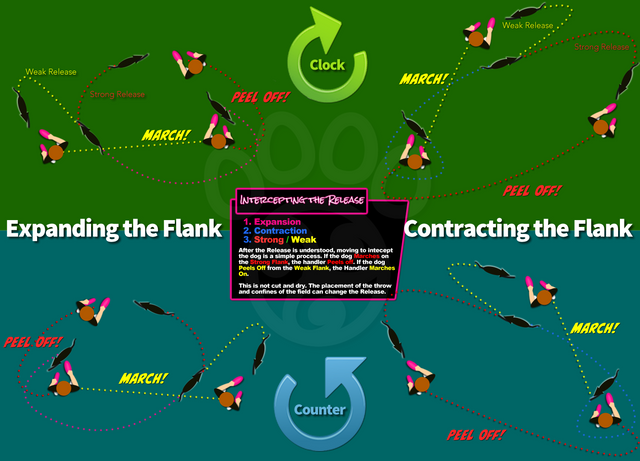Disc Dog Flatwork | Mechanics of the Intercepted Release


Jumping off from the Flatwork Mechanics piece yesterday, the Mechanics of the Intercepted Release looks to be a crazy, complex operation, but it’s not at all. [Click the image for full sized version]
If the dog marches on, the handler peels off. If the dog peels off the handler marches on.
Creating the Working Flank
When Intercepting the Release, the handler needs to hook up with the dog on the Working Flank. This Working Flank creates a starting point of connection. Dog and handler are moving in the same direction as a team. This is a key element of successfully Intercepting the Release.
Without the Working Flank, the team is not connected and it is quite difficult to get a move started. If you have tried to do an over or a vault while your dog is arcing in towards you as opposed to coming straight in, you probably know that the dog is likely to slide outside of your position to maintain the flank. Doing a Leg Over while the dog is arcing in usually leads to the Over happening outside your leg, going over nothing but air. The same happens with a vault.
Getting a straight line approach for the vault or over is key. This is normally accomplished with a Rear Cross (Squib) or a twisting maneuver to line your dog up and get the trick started. This is cool, but not necessary.
Front Cross as Trigger
If the Working Flank is established, the dog can be pulled in to a straight line approach with a Front Cross. This Front Cross from the Working Flank is the trigger.
If the dog is on a clockwise release after catch, the handler should be too. So get hooked up on that flank and pull the dog a bit. Once some team movement is established, changing to the Counter Clock Flank with the Front Cross will set up the linear approach needed for a vault or over.
Without an established Working Flank, there can be no cross, and getting the dog off their Strong Flank to drive towards the handler will be near impossible
Handler Peeling Off
If the dog continues on the flank, the handler peels off. This movement allows the handler to set up the Working Flank for a moment. By turning in the opposite direction of the flank, the handler sucks the dog in a bit while orienting the team onto the Working Flank. This sucking in movement keeps the dog arcing until you decide to start your trick with the Front Cross.
Simply make your throw and spin in the opposite direction of your dog’s flank. If the dog is on the Clock Flank, you will peel off counter clock. While peeling off, you will wind up with your left hand towards the dog in that clockwise Working Flank Position. Hold there, grab the dog on the flank, and work for a moment. When you’re in position or otherwise ready to go, switch flanks with the Front Cross and you’re straight line approach is all set up.
Handler Marches On
If the dog peels off from the Weak to the Strong Flank, simply walk forward with your body oriented in the same direction as your dog. So if your dog is counter strong and has peeled off to the Counter Clock Flank, orient your body so your right side is towards the dog. From this counter clock Working Flank, a Front Cross to the Clock Flank will line the dog up and trigger the start of the trick.
Almost Better Than a Wait
Done well, Intercepting the Release is almost better than a Wait. It gets the team in position and lined up without the trouble of timing the start or trigger from a Wait. It creates a rolling start, and it’s smooth, as rolling starts tend to be.
Balanced Dogs, Disc Placement and Pressure
Balanced dogs are tough to do this with. You can’t really trust them to go in the same direction every time. To confidently and successfully Intercept the Release requires confidence in the directional choice of the dog. Balanced dogs are far more sensitive to pressure and disc placement and tend to make their directional decisions on the fly. This makes it hard for the handler to commit to a direction while the dog is making the catch. Unbalanced dogs are very reliable on their directional preference.
Field pressure, or pressure coming from something on the field or adjacent to the field can dramatically alter the dog’s Release. Even the most unbalanced dogs will go in their weak direction if the field or an obstacle puts enough pressure on them. If something weird happens and your dog goes the wrong way, look for some form of pressure that may be impacting the dog. Agility equipment on the UpDog field, a pole or tree, and the sidelines of the field, are a few common illustrations of these anomalous pressure situations.
Disc placement can also be quite key in the reliability of the Release. Too far or too fast a throw can alter the Release. There is a difference between throwing to set the flank and throwing on the flank. More on that later.
Posted from my blog with SteemPress : http://pvybe.com/disc-dog-training/on-discdog-flatwork/disc-dog-flatwork-mechanics-of-the-intercepted-release/